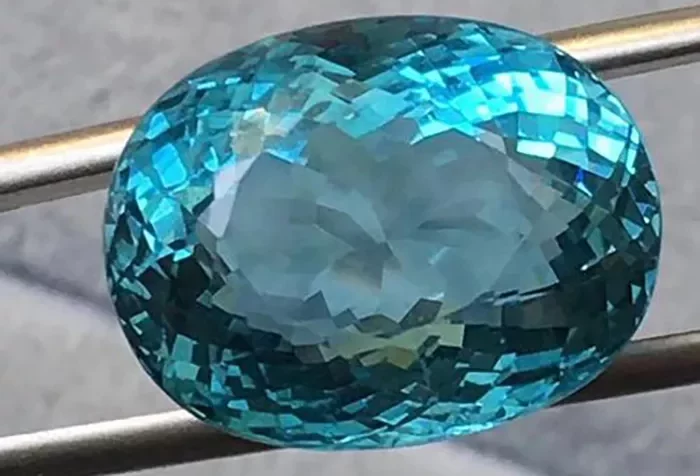Aquamarine is a popular gemstone that is known for its beautiful blue-green color. However, with its popularity comes the risk of encountering fake or synthetic aquamarine gemstones. In this article, we will explore how to distinguish between genuine and fake aquamarine gemstones from a professional appraiser’s perspective.
What is Aquamarine?
Aquamarine is a variety of beryl that is typically found in granite pegmatites and alluvial deposits. It is a mineral that is composed of beryllium aluminum silicate, and gets its blue-green color from the presence of iron in the crystal structure. Aquamarine is typically found in Brazil, Madagascar, and other locations around the world.
Physical Properties of Aquamarine
Aquamarine has a hardness of 7.5 to 8 on the Mohs scale, which means that it is a relatively hard gemstone that is resistant to scratches and abrasions. It has a specific gravity of 2.68 to 2.74, which is a measure of its density compared to water. Aquamarine is typically more transparent than other types of beryl, and has a high level of brilliance and sparkle.
The appearance of aquamarine
The appearance of blue sapphire is typically deep blue or light blue, but it can also be other colors such as green, yellow, pink, etc. The color of blue sapphire is usually uniform, but it may also have stripes and spots. The appearance of blue sapphire also depends on its cutting style. If it is cut well, its appearance will be very clear and transparent, otherwise it will appear blurry and unclear. The appearance of blue sapphire may also be affected by its inclusions and flaws.
Here are several differences between blue sapphire and other gemstones:
1. Chemical composition: Blue sapphire is composed of aluminum oxide, while other blue gemstones such as blue topaz and blue zircon have different chemical compositions.
2. Hardness: Blue sapphire has a hardness of 9, which is the same as that of blue topaz, but lower than that of blue zircon.
3. Color: Blue sapphire is typically deep blue or light blue, while blue topaz is typically light blue or colorless, and blue zircon is typically deep blue or colorless.
4. Origin: Blue sapphire is primarily found in Sri Lanka, Myanmar, and Thailand, while blue topaz is primarily found in Brazil, Nigeria, and Sri Lanka, and blue zircon is primarily found in Australia, South Africa, and the United States.
5. Usage: Blue sapphire is commonly used in high-end jewelry such as wedding rings, necklaces, and bracelets, while blue topaz and blue zircon are also used in jewelry making, but typically for wearable and decorative items.
See also: Why Choose an Ernest Jones Aquamarine Ring for Your Collection?
How to Distinguish Between Genuine and Fake Aquamarine Gemstones
1. Color
The color of aquamarine can vary from a pale blue-green to a deep blue-green, depending on the amount of iron present in the crystal structure. Genuine aquamarine gemstones have a natural and consistent color, while fake or synthetic aquamarine gemstones may have an inconsistent or unnatural color. Be wary of aquamarine gemstones that have a bright or vivid blue-green color, as this may be a sign that the gemstone is synthetic.
2. Clarity
Genuine aquamarine gemstones are typically more transparent than other types of beryl, and have a high level of brilliance and sparkle. Be wary of aquamarine gemstones that have inclusions or other imperfections, as this may be a sign that the gemstone is fake or synthetic.
3. ardness
Aquamarine has a hardness of 7.5 to 8 on the Mohs scale, which means that it is a relatively hard gemstone that is resistant to scratches and abrasions. Genuine aquamarine gemstones should not scratch easily, while fake or synthetic aquamarine gemstones may be more prone to scratches and abrasions.
4. Weight and Specific Gravity
Aquamarine has a specific gravity of 2.68 to 2.74, which is a measure of its density compared to water. Genuine aquamarine gemstones should have a consistent weight and specific gravity, while fake or synthetic aquamarine gemstones may have a lower weight or specific gravity.
5. Price
Genuine aquamarine gemstones can be expensive, particularly if they are of high quality and have a deep and vibrant blue-green color. Be wary of aquamarine gemstones that are priced significantly lower than other similar gemstones, as this may be a sign that the gemstone is fake or synthetic.
Conclusion
Aquamarine is a popular gemstone that is known for its beautiful blue-green color. However, with its popularity comes the risk of encountering fake or synthetic aquamarine gemstones. As a professional appraiser, I recommend using the above methods to distinguish between genuine and fake aquamarine gemstones. Be wary of aquamarine gemstones that have an inconsistent or unnatural color, inclusions or other imperfections, are prone to scratches and abrasions, have a lower weight or specific gravity, or are priced significantly lower than other similar gemstones. It is also important to consult with a reputable jeweler or appraiser to determine the quality and value of an aquamarine, as well as provide guidance on the best investment strategy based on your individual needs and preferences.
Related topic:
- What is Cat’s Eye Aquamarine?
- How to Revive Dull Aquamarine Gemstones Effectively
- How to Choose the Best Cushion Cut Aquamarine Gemstone


